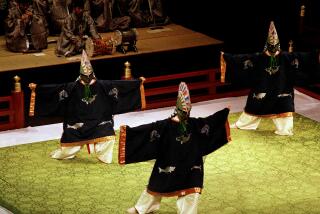Review: And NOW, for something different at REDCAT
- Share via
The annual summer New Original Works Festival at REDCAT has caught on. Close to 150 applications from local artists were received for the 15th iteration of the series, which began Thursday and involves three weeks of multi-culti, multi-ethnic, multi-media, multi-disciplinary, multi-everything-under-the-sun programs, each week offering something new. The opening night was sold out, and rightfully so for a town that thinks of itself as 21st century to the max.
But what does it all mean?
An intriguing place to begin is with the artist bios. We’ve surely reached an authentically post-genre age. Furthermore, our more questing artists increasingly assume the role of healers contending with an ailing Earth, collectively sickened psyches and fractured societies, bringing to bear a myriad of unexpected skills.
For instance, Morgan Sorne, who goes by Sorne and who supplied the music for the first piece, “Eat Your Young,” is a visual artist, musician, actor and filmmaker whose “hypnotic angelic falsetto” is capable of churning “crowds into a writhing frenzy with his bone-rattling dynamicism [sic] and range.”
Singer Jasmine Orpilla, co-creator of the second piece, “About How Many Years Did We Fight the Beast Together,” a kind of opera inspired by traditional Filipino music and dance, is a “ritual performance artist,” soprano and experimental composer and dancer.
Jmy James Kidd, the choreographer for the third work, “Solid, Like a Rock,” “designs dances, clothing and spaces.” Among its 22 dancers are a “holistic Pilates instructor, movement coach and energy healer”; an “artist, musician, dance maker, yogini, former university professor and homo sapien”; a dancer, choreographer, performance artist and model; a dancer, actress, choreographer and filmmaker; and a dancer who “cultivates a practice of everyday poetics and magic to summon untold histories and dive into the semiotics of body memory.”
If this all sounds so, well, L.A., so be it. At this disquieting moment in time, there is something ineffably heartening about committed and searching artists with diverse skills and imagination. Each piece in this first trio of works offered a way out. Out of what wasn’t always clear, perhaps, but the reasons for getting out are compelling.
In “Eat Your Young,” Sorne, dressed in a three-piece suit and barefoot, produced waves of consonant-free, ether-filling song, electronically enhanced, along with added percussion effects. I didn’t notice any writhing frenzy around me, but there was a good, strong sonic wash.
Meanwhile, Miwa Matreyek — an animator, director, designer and performer — created shadow dances behind a small video screen. Her arms protruded over and under an seascape idyllic on the surface but beneath which floated yogurt containers and other material destined to contaminate the environment. This became more ominous, but no less beautiful, when the projection changed into an arboreal mandala eventually decaying into man-made urban destruction. Here, Matreyek may have been the shadow of humanity struggling to survive, while nature somehow retained its wonder.
More shadow dancers appeared in “How Many Years,” this time behind a sheet with no projections. Orpilla, in traditional Filipino dress, is a vocalist whose Tagalog-inflected song proved as effusive as Sorne’s keening. Her collaborator was choreographer, dancer and ethnologist Peter de Guzman. The dances came from the Pangalay tradition. Three musicians accompanied on an arrangement of kulintang gongs. I found the content indecipherable but not the ritual sensibility that seemed to evoke higher, better powers.
“Solid, Like a Rock” began with Tara Jane O’Neil at the rear of the stage hunched over an electric guitar, making drones. The dancers, in white or blue jump suits, entered on all fours, like sheep. Eventually, they were writhing on their backs, but not in frenzy, rather like a school of fish and then like petals in the wind propelled into a living flower.
Once erect, however, they found their frenzy like living Matisse dancers, except displaying a mix of ages and body shapes. And it was joy.
This, the longest of the three pieces, is only 23 minutes. The works, then, function like a sliver in time and place. After each, in a different way, the world looked a slightly more inhabitable and L.A. a little better poised to make a difference.
More to Read
The biggest entertainment stories
Get our big stories about Hollywood, film, television, music, arts, culture and more right in your inbox as soon as they publish.
You may occasionally receive promotional content from the Los Angeles Times.











